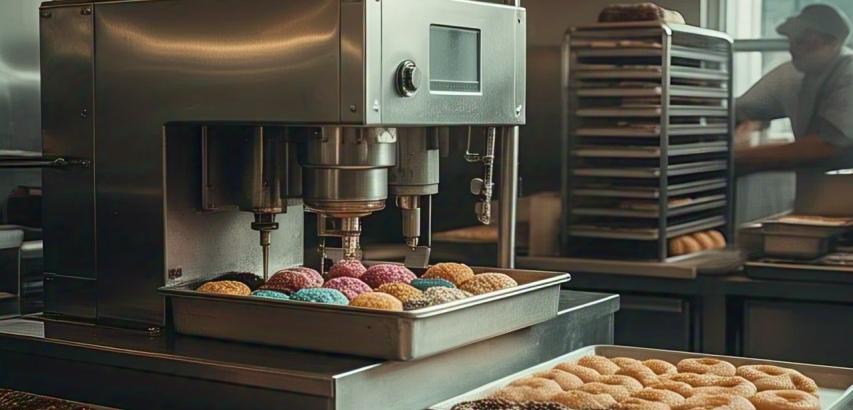A donut filling machine is a specialized piece of equipment designed to inject fillings—such as jam, custard, cream, or fruit preserves—into donuts with speed, consistency, and hygiene. Ideal for bakeries, food manufacturers, and large-scale donut shops, these machines automate the traditionally labor-intensive process of filling, ensuring uniform product quality and reducing waste.
Key Features and Technology
Filling Mechanism:
Pneumatic or Hydraulic Pumps: Deliver precise amounts of filling (1g–50g+) per donut.
Multi-Nozzle Systems: Allow simultaneous filling of multiple donuts or varied flavors.
Adjustable Settings:
Control filling volume, injection depth, and speed (typically 500–3,000+ donuts/hour).
Hygienic Design:
Food-grade stainless steel construction with easy-to-clean, disassemblable parts.
Versatile Fill Compatibility:
Handles thick (e.g., custard) and thin (e.g., fruit syrup) fillings without clogging.
Automated Feeding:
Conveyor belts or rotary systems position donuts under nozzles for continuous operation.
Smart Controls:
Touchscreen interfaces with preset programs for different fill types and donut sizes.
IoT-enabled models for remote monitoring and diagnostics.
Types of Donut Filling Machines
Manual/Semi-Automatic Fillers:
Operated via foot pedal or hand lever; ideal for small bakeries or artisanal producers.
Automatic Rotary Fillers:
High-speed systems with rotary tables for large-scale production (e.g., 2,000+ donuts/hour).
Inline Production Systems:
Integrated with donut fryers, glazers, and packaging lines for end-to-end automation.
Multi-Flavor Fillers:
Equipped with dual reservoirs to inject two fillings (e.g., chocolate and raspberry) in one pass.
Applications
Commercial Bakeries: High-volume filling for jelly, Boston cream, or custard donuts.
Food Service Chains: Consistent filling for branded products (e.g., Dunkin’s Bavarian Kreme).
Specialty Shops: Custom fillings like matcha, dulce de leche, or vegan alternatives.
Frozen Donut Production: Precise filling for pre-packaged, frozen donuts.
Advantages
Consistency: Uniform filling distribution in every donut.
Labor Savings: Reduces reliance on skilled workers for manual injection.
Increased Output: Processes hundreds to thousands of donuts per hour.
Reduced Waste: Minimizes overfilling or underfilling errors.
Hygiene: Closed systems prevent contamination and meet food safety standards (e.g., HACCP).
Considerations
Initial Cost: Ranges from 500 to 150,000+ (fully automated lines).
Maintenance: Regular cleaning of nozzles and pumps to prevent clogging.
Filling Viscosity: Requires adjustments for different textures (e.g., thick caramel vs. runny jelly).
Space Requirements: Larger systems need dedicated production floor space.
Training: Operators must learn to calibrate settings and troubleshoot issues.
Popular Models and Brands
Reiser Vemag Donut Filler: High-speed volumetric filler for precise portion control.
C.B. Snack Filling Machine: Compact, semi-automatic systems for SMEs.
Rademaker Automated Lines: Integrated solutions for industrial-scale donut production.
Unifiller Food Injection Systems: Versatile pumps for creative fillings.
Innovations and Trends
AI-Powered Quality Control: Cameras detect unfilled donuts and adjust injection in real time.
Eco-Friendly Design: Machines with reduced energy/water consumption.
Portable Fillers: Battery-operated units for food trucks or pop-up shops.
3D Printing Integration: Custom-shaped nozzles for decorative filling patterns.
A donut filling machine is a game-changer for businesses aiming to scale production while maintaining the artisanal quality of filled donuts. By automating the injection process, it ensures every bite is as flavorful as the last, whether for mass-market brands or gourmet bakeries. While the upfront investment and maintenance require careful planning, the long-term benefits—enhanced efficiency, reduced labor costs, and consistent customer satisfaction—make it a valuable asset. As consumer demand for innovative and high-quality filled donuts grows, advancements in smart technology and sustainable design will continue to elevate this equipment’s role in the competitive food industry.
 |  |  |
